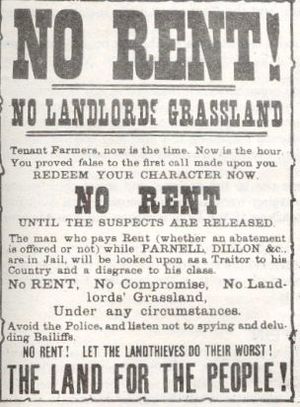Land Commission facts for kids
The Irish Land Commission was a special group set up in Ireland a long time ago, in 1843, by the British government. Its main job was to look into how land was being used and owned in Ireland. Later, starting in 1881, it became very important for setting fair rents for farmers. For about 100 years, this commission was in charge of sharing out farmland across most of Ireland. It finally closed down in 1999.
Contents
Helping Farmers Buy Land
After 1885, the Land Commission started helping farmers buy the land they worked on. Before this, many farmers rented land from big landlords. This change happened because there was a lot of trouble, known as the Land War, where farmers were fighting for better rights. The government wanted to help farmers own their land to stop these problems. They even provided money to help farmers buy their farms.
By 1920, the Commission had helped transfer a huge amount of land – about 13.5 million acres! A new law in 1903 made it easier for farmers to buy their land. The government lent them money, and farmers would pay it back over many years. The Land Commission had to make sure the prices were fair for everyone.
Challenges with Small Farms
However, a problem soon appeared: many of the new farms were quite small. It was hard for farmers to earn enough money to live well on these small pieces of land. The goal was to create "peasant proprietors," meaning farmers who owned their small farms. But this often meant breaking up larger, more productive farms into smaller ones.
Another law in 1909 allowed the Land Commission to buy land even if the owner didn't want to sell it. This was called "compulsory purchase." By 1915, the British government had spent over £91 million helping Irish farmers buy land.
Land During the War of Independence
During the Irish War of Independence in the early 1920s, some farms were taken over. In 1920, the Dáil, which was the Irish parliament at the time, decided that no one should make claims about land ownership until the war was over.
A New Start for the Commission
When the Irish Free State was formed in 1922, many old offices that covered all of Ireland were closed. This included the Land Commission. However, the Land Commission was quickly started up again in 1923 for the new Irish Free State. Its job was to continue helping farmers buy land.
Land in Northern Ireland
In Northern Ireland, which remained part of the United Kingdom, the Land Commission's work changed in 1925. Its activities there finally ended in 1935.
Land Laws in the Irish Free State
The Land Commission in the Irish Free State was given new powers. It could now buy land that wasn't being farmed, especially if it was owned by someone who wasn't Irish. This land was then divided among local families. However, this didn't happen everywhere, and some big farms stayed together if they were being actively used.
Farmers continued to pay back their land loans, which were called "land annuities," to the British government. By 1925, many farmers still had very small farms that didn't provide enough income. Despite this, the government kept dividing larger landholdings, partly to gain support from voters.
Paying for the Land
In 1933, a new law allowed the Irish government to use the money from these land payments for local projects instead of sending it to Britain. This caused a disagreement, known as the Anglo-Irish Trade War, between Ireland and Britain. The issue was finally settled in 1938 with a one-time payment to Britain.
The Land Commission helped many people own their land, which was seen as a step towards fairness. However, there were also some problems. Dividing land into very small farms sometimes made it hard for farmers to make a good living. Also, some beautiful old houses on landlords' estates were destroyed. As farming became more modern, the way land was divided sometimes discouraged new investments in farms.
Changes and the End of the Commission
Over time, some people argued that Ireland should encourage larger farms instead of creating many small ones. They believed bigger farms would be more successful. However, others, like Éamon de Valera, wanted to continue supporting small farmers for social and political reasons.
Renting Land and New Challenges
Because of the old laws, many busy farmers had to rent extra land for short periods, usually 11 months. This was called the "conacre" system. If they rented for longer, they risked losing their farm to compulsory purchase by the Land Commission. While many more Irish people now owned land, this short-term renting meant farmers didn't have much reason to improve the rented land. By 1980, a lot of land was still rented this way. Modern farm machines also work better on larger farms.
In 1965, a law was passed to limit foreign investment in Irish farming. This was partly because Ireland was planning to join the European Economic Community (now the European Union) in 1973. When Ireland joined, people from other EEC countries could invest freely, which went against the Land Commission's original goals.
By the 1980s, the Land Commission was part of the Department of Agriculture. In 1983, it stopped buying new land. This was the beginning of the end for the commission's work in changing land ownership. The Land Commission had many staff, and its budget was quite large, with a lot of money going to administration. The Irish Land Commission was officially closed down in 1999.


